Dynamic Spatiotemporal Land Use Evolution in China’s Plateau Lake Basins in Response to Landscape Ecological Sensitivity
Abstract
:1. Introduction
2. Study Area and Data Source
2.1. Overview of the Study Area
2.2. Data Source and Processing
3. Methods
3.1. Land-Use Dynamic Attitude
3.2. Land-Use Transfer Matrix
3.3. Land-Use Changes
3.4. Ecological Sensitivity Assessment
3.4.1. Selection of Influencing Factors
3.4.2. Determination of the Weights of Influencing Factors
3.4.3. Establishment of the Judgment Matrix
3.4.4. Weighted Overlay Analysis
4. Results and Analysis
4.1. Analysis of Land-Use Change
4.1.1. Temporal and Spatial Dynamics of Land Use
4.1.2. Land-Use Dynamic Attitude
4.1.3. Characteristics of Land-Use Transfer
4.2. Landscape Ecological Sensitivity Assessment
4.2.1. Selection of Single-Factor Landscape Ecological Sensitivity Assessment Factors
4.2.2. Single-Factor Landscape Ecological Sensitivity Assessment Results
4.2.3. Comprehensive Assessment of Ecological Sensitivity
5. Discussion
6. Conclusions
- (1)
- It was necessary to analyze remote-sensing data to solve the issue of the land classification of ecologically fragile and plateau areas. The main land area in 1990–2020 was woodland, with an annual average of approximately 45.05%, followed by grassland, accounting for approximately 26.20%. During the past 30 years, the range of various land-use types has changed. Woodland, built-up land, and unutilized land have demonstrated an increasing trend, whereas cultivated land and grassland have demonstrated a decreasing trend. The water area has remained unchanged. Among the transferred areas, the cultivated land area and the building area were the largest, demonstrating that the development of tourism and population growth have promoted urbanization. Climate change and ecological restoration projects have promoted the ecological protection of the Erhai Lake Basin.
- (2)
- With the evolution of land use, we could clearly understand the changes in land use in the study area, with a particular impact on ecological sensitivity. Our single-factor ecological sensitivity assessment had 11 influencing factors; essential indicators for the evaluation of a sea basin. Vegetation coverage and the distance from the water system were necessary influencing factors for natural conditions, accounting for a relatively large proportion. Land use and the distance from a road played a key role in human activities, whereas landslides, collapses, and slopes had less of an influence. The ecological value of the Erhai Lake Basin is remarkable; thus, biodiversity factors were also noted to be important indicators.
- (3)
- The comprehensive sensitivity of the overall study area was 1102.36 km2 (26.16%) and the higher sensitivity area was 1177.10 km2 (27.93%). Ecological sensitivity gradually increased from residential areas to nature reserves. The high-sensitivity areas in the study area were widely distributed, which is more conducive to multi-mode protection and planning. The high-sensitivity and higher sensitivity areas were mainly distributed in mountainous woodlands and grasslands, as well as areas extending 100 m away from the west side of Erhai Lake. In areas with fewer human activities, human interference resistance was weak, which could strengthen the ecological restoration function of the area and protect its ecological function. The medium-sensitivity areas were mainly distributed in the transition areas, from residential areas to nature reserves such as cultivated land and water areas. Limiting development activities and strengthening land-use monitoring are necessary to reduce human intervention in nature. The low-sensitivity and lower sensitivity areas were mainly distributed around the waters and residential areas, mainly areas of human activity. These were close to the water. Thus, it is possible to ensure a degree of intensity for open construction whilst improving basic service facilities, establishing green corridors, broadening lakeside buffer spaces, and protecting the ecological security of water resources in the basin [71].
Author Contributions
Funding
Institutional Review Board Statement
Informed Consent Statement
Data Availability Statement
Conflicts of Interest
References
- Hooper, T.; Beaumont, N.; Griffiths, C.; Langmead, O.; Somerfield, P.J. Assessing the sensitivity of ecosystem services to changing pressures. Ecosyst. Serv. 2017, 24, 160–169. [Google Scholar] [CrossRef]
- Zhao, Z.Y.; Zhang, Y.T.; Lii, Y.H.; Wang, C.; Wu, X. Comprehensive evaluation and spatio-temporal variations of ecological sensitivity on the QinghaiTibet Plateau based on spatial distance index. Sheng Tai Xue Bao 2022, 42, 7403–7416. [Google Scholar]
- Zhou, Y.L.; Yang, Y.F.; Yuan, W.Y. Analysis and Evaluation on Ecological Sensitivity of Xiaoqinghe River Basin in Jinan Based on GIS. J. Northwest For. Univ. 2016, 31, 50–56+62. [Google Scholar]
- Gashaw, T.; Tulu, T.; Argaw, M.; Worqlul, A.W.; Tolessa, T.; Kindu, M. Estimating the impacts of land use/land cover changes on ecosystem service values: The case of the Andassa watershed in the upper Blue Nile basin of Ethiopia. Ecosyst. Serv. 2018, 31, 219–228. [Google Scholar] [CrossRef]
- You, N.S.; Meng, J.J. Ecological Functions Regionalization and Ecosystem Management Based on the Ecological Sensitivity and Ecosystem Service in the Middle Reaches of the Heihe River. J. Desert Res. 2017, 37, 186–197. [Google Scholar]
- Chapman, S.; Mustin, K.; Renwick, A.R.; Segan, D.B.; Hole, D.G.; Pearson, R.G.; Watson, J.E.M.; Richardson, D. Publishing trends on climate change vulnerability in the conservation literature reveal a predominant focus on direct impacts and long timescales. Divers. Distrib. 2014, 20, 1221–1228. [Google Scholar] [CrossRef]
- Chandra, A.; Gaganis, P. Deconstructing vulnerability and adaptation in a coastal river basin ecosystem: A participatory analysis of flflood risk in Nadi, Fiji Islands. Clim. Dev. 2016, 8, 256–269. [Google Scholar] [CrossRef]
- Ding, H.; Zhao, X.M.; Guo, X. Evaluation of ecological sensitivity in Poyang Lake area of Jiangxi Province. Res. Soil. Water Conserv. 2020, 27, 257–264. [Google Scholar]
- Chen, S.; Jiang, W.; Chen, Y.; Wang, X. An ecological sensitivity analysis based on GIS in Fuyang District, Hangzhou City, Zhejiang Province, China. J. Zhejiang AF Univ. 2015, 32, 837–844. [Google Scholar]
- Duan, Y.Q.; Zhang, L.D.; Fan, X.Y.; Hou, Q.H.; Hou, X.M. Smart City oriented Ecological Sensitivity Assessment and Service Value Computing basedon Intelligent sensing data processing. Comput. Commun. 2020, 160, 263–273. [Google Scholar] [CrossRef]
- Turner, B.L.; Kasperson, R.E.; Matson, P.A.; McCarthy, J.J.; Corell, R.W.; Christensen, L.; Eckley, N.; Kasperson, J.X.; Luers, A.; Martello, M.L.; et al. A framework for vulnerability analysis in sustainability science. Proc. Natl. Acad. Sci. USA 2003, 100, 8074–8079. [Google Scholar] [CrossRef] [PubMed]
- Butt, M.A.; Nisar, K.; Mahmood, S.A.; Sami, J.; Qureshi, J.; Jaffer, G. Toward GIS–based approach for identification of ecological sensitivity areas: Multi–criteria evaluation technique for promotion of tourism in Soon ValleyPakistan. J. Indian. Soc. Remote Sens. 2019, 47, 1527–1536. [Google Scholar] [CrossRef]
- Peng, B.; Huang, Q.; Elahi, E.; Wei, G. Ecological environment vulnerability and driving force of Yangtze River urban agglomeration. Sustainability 2019, 11, 6623. [Google Scholar] [CrossRef]
- Ersayin, K.; Tagil, S. Ecological sensitivity and risk assessment in the Kizilirmak Delta. Fresenius Environ. Bull. 2017, 26, 6508–6516. [Google Scholar]
- Palmer, M.A.; Reidy Liermann, C.A.; Nilsson, C.; Flörke, M.; Alcamo, J.; Lake, P.S.; Bond, N. Climate change and the world’s river basins: Anticipating management options. Front. Ecol. Environ. 2008, 6, 81–89. [Google Scholar] [CrossRef]
- Creamer, R.E.; Hannula, S.E.; Van Leeuwen, J.P.; Stone, D.; Rutgers, M.; Schmelz, R.M.; De Ruiter, P.C.; Hendriksen, N.B.; Bolger, T.; Bouffaud, M.L.; et al. Ecological network analysis reveals the inter–connection between soil biodiversity and ecosystem function as affected by land use across Europe. Appl. Soil Ecol. 2016, 97, 112–124. [Google Scholar] [CrossRef]
- Steenberg, J.W.; Millward, A.A.; Nowak, D.J.; Robinson, P.J.; Ellis, A. Forecasting urban Forest ecosystem structure, function, and vulnerability. J. Environ. Manag. 2017, 59, 373–392. [Google Scholar] [CrossRef]
- Gonzalez, P.; Neilson, R.P.; Lenihan, J.M.; Drapek, R.J. Global patterns in the vulnerability of ecosystems to vegetation shifts due to climate change. Global Ecol. Biogeogr. 2010, 19, 755–768. [Google Scholar] [CrossRef]
- Pielke, R.A.; Avissar, R. Influence of landscape structure on localand regional climate. Landsc. Ecol. 1990, 4, 133–155. [Google Scholar] [CrossRef]
- Yu, J.; Li, F.; Wang, Y.; Lin, Y.; Peng, Z.; Cheng, K. Spatiotemporal evolution of tropical forest degradation and its impact on ecological sensitivity: A case study in Jinghong, Xishuangbanna, China. Sci. Total Environ. 2020, 727, 138678. [Google Scholar] [CrossRef]
- Li, T.; Liu, K.; Ma, L.Y.; Bao, Y.B.; Wu, L. Evaluation on resolution Effects driven by land use changes over Danjiang River basin of Qinling Mountain. J. Nat. Resour. Policy Res. 2016, 31, 583–595. [Google Scholar]
- Qu, S.; Wang, L.; Lin, A.; Yu, D.; Yuan, M.; Li, C.a. Distinguishing the impacts of climate change and anthropogenic factors on vegetation dynamics in the Yangtze River Basin, China. Ecol. Indic. 2020, 108, 105724. [Google Scholar] [CrossRef]
- Kong, Y.F. Study on the Ecological Planning of Jixi National Wetland Park based on Ecological Sensitivity Evaluation. Master’s Thesis, Shandong Jianzhu University, Jinan, China, 2015. [Google Scholar]
- Wang, S. Liaoning Province ecological sensitivity evaluation and its driving forces. J. Nat. Sci. Res. 2021, 1, 35–38. [Google Scholar]
- Wei, W.; Zhou, T.; Guo, Z.C.; Li, Z.Y.; Zhang, X.Y. Spatiotemporal evolution of land ecological sensitivity in arid inland river basin based on remote sensing index: A case of Wuwei City in Shiyang River Basin. Chin. J. Ecol. 2020, 39, 3068–3079. [Google Scholar]
- Zhang, H.X.; Liu, L.R. Evaluating ecological environmental sensitivity in poor county of Lyuliang mountain area based on GIS. Ecol. Appl. 2020, 39, 30–37. [Google Scholar]
- Xuan, L.; Huang, C.; Chen, W.; Wang, X.; Bai, X.; Yin, Z.; Li, X.; Han, J. Ecological sensitivity assessment based on GIS and Analytic Hierarchy Process: Case study of Longnan county in Jiangxi province. Nanchang Univ. J. Nat. Sci. 2019, 43, 599–605. [Google Scholar]
- Fotheringham, A.S.; Charlton, M.E.; Brunsdon, C. Geographically weighted regression: A natural evolution of the expansion method for spatial data analysis. Environ. Plan. A 1998, 30, 1905–1927. [Google Scholar] [CrossRef]
- Zhu, F.; Zhang, H.W. “AHP + entropy weight method” based CW–TOPSIS model for predicting rockburst. China Saf. Sci. J. 2017, 27, 128–133. [Google Scholar]
- Sun, L.; Xu, D.; Liu, B. Research on Ecological Sensitivity Evaluation of Yellow River Scenic Area in Zhengzhou. For. Resour. Manag. 2022, 6, 95–100. [Google Scholar]
- Cuicui, W. Study on Evaluation Method of Ecological Sensitivity in Lanzhou Section of Yellow River Basin. Master’s Thesis, Lanzhou Jiaotong University, Lanzhou, China, 2022. [Google Scholar]
- Ouyang, Z.Y.; Wang, X.K.; Miao, H. China’s eco–environmental sensitivity and its spatial heterogeneity. Sheng Tai Xue Bao. 2020, 20, 9–12. [Google Scholar]
- Chen, W.; Zhao, Y.; Cui, D.; Lü, S.; Lu, J.; Muyassar, S. Ecological sensitivity study of oasis supported by GIS: A case study of Yili river valley. Bull. Surv. Mapp. 2023, 5, 107–114. [Google Scholar]
- Zheng, S.Y.; Li, Y.Q.; Dong, Y.K.; Wang, J.X. Research on the Spatio–temporal Variation of NDVI in Erhai Lake Basin Under the Influence of Multi–factors. Lemmer 2022, 29, 83–98. [Google Scholar]
- Lin, R. Ecological Sensitivity Assessment of the Central Route of South-to-North WaterDiversion Project Reserve. Master’s Thesis, China University of Mining and Technology, Beijing, China, 2019. [Google Scholar]
- Ma, L.; Li, B. Matching degrees between ecological sensitivity and land-use functions: A study of The WestCoast of Qingdao New District. J. Beijing Norm. Univ. (Nat. Sci.) 2018, 54, 412–419. [Google Scholar]
- Jing, Y. Land Use Changes in Lanzhou New Area Impact on Ecological Environment and Evaluation. Master’s Thesis, Gansu Agricultural University, Lanzhou, China, 2018. [Google Scholar]
- Hao, S.; Su, L.; Guo, Y. Effects of Land Use Changes on Ecological Sensitivity of Nyang River Basin in Tibet. Bull. Soil Water Conserv. 2023, 43, 303–309. [Google Scholar]
- Liu, H.; Sun, L.H.; Lv, W.K. Evaluation and Change Analysis of Ecosystem Service Value in Erhai Lake Basin Based on Land Use Change. Ecol. Econ. 2022, 38, 147–152. [Google Scholar]
- Du, Y.Y.; Hu, Y.N.; Yang, Y.; Peng, J. Building ecological security patterns in southwestern mountainous areas based on ecological importance and ecological sensitivity: A case study of Dali Bai Autonomous Prefecture, Yunnan Province. Acta Ecol. Sin. 2017, 37, 8241–8253. [Google Scholar]
- Ma, Y.J.; Huang, X.J.; Xu, M.M.; Zhong, T.Y.; Du, W.X. Sensitivity Analysis of Ecosystem Service Value to Coastal Tideland Development in Jiangsu Province. China Land Sci. 2006, 20, 28–34. [Google Scholar]
- He, S.L.; Zou, F.Q.; Wang, J.L. Ecological sensitivity evaluation of Longnan County based on AHP and MSE weighting method. Chin. J. Ecol. 2021, 40, 2927–2935. [Google Scholar]
- Lu, Y.; Li, H. Spatio–temporal dynamic evolution of habitat quality based on land use change from 2000 to 2020: Taking Wuhan metropolitan area as an example. Res. Soil Water Conserv. 2022, 29, 391–398. [Google Scholar]
- Xu, X.L.; Liu, J.Y.; Zhang, Z.X.; Zhou, W.C.; Zhang, S.W.; Li, R.D.; Yan, C.Z.; Wu, S.X.; Shi, X.Z. A Time Series Land Ecosystem Classification Dataset of China in Five-Year Increments (1990–2010). J. Global Change Data Discov. 2017, 1, 52–59. [Google Scholar] [CrossRef]
- Xu, X.L.; Pang, Z.G.; Yu, X.F. Spatial-Temporal Pattern Analysis of Land Use/Cover; Scientific and Technical Documentation Press: Beijing, China, 2014. [Google Scholar]
- Peng, W.; Sitong, Q.; Huirong, H. Spatial-temporal evolution characteristics of land use change and habitat quality in the Lhasa River Basin over the past three decades. JAL 2023, 40, 492–503. [Google Scholar]
- Yao, P.; Yunhe, Y.; Wenjuan, H.; Han, H.X. Temporal and spatial variation characteristics of habitat quality in the source region of the Yellow River based on land use and vegetation cover change. Sheng Tai Xue Bao 2022, 42, 7978–7988. [Google Scholar]
- Andong, H.; Mingsong, Z.; Min, G. Spatial–temporal evolution characteristics of land use in Anhui Province from 1980 to 2020. STEJ 2022, 22, 4627–4635. [Google Scholar]
- Boyang, W.; Yingjie, G.; Chunfeng, L. Developing ecological protection strategies for scenic spots based on ecological sensitivity-A case study of Yaoshan Scenic Spot. J. Gansu Agric. Univ. 2023, 58, 180–188+199. [Google Scholar]
- Xi, W.; Sanyou, C.; Yingjie, L. Study on land use change and ecological sensitivity in 30 years based on Landsat TM and Oll data–aase study of Qinling Mountains of Huyi District in Xi’an. J. Quat. Sci. 2022, 42, 1655–1672. [Google Scholar]
- Bei, Z. Ecological Protection and Utilization of Xuefeng Mountain National Forest Park Based on Ecological Sensitivity Evaluation. Master’s Thesis, Central South University of Forestry & Technology, Changsha, China, 2021. [Google Scholar]
- Jiali, W.; Xiaogang, W.; Shiyu, L.; Yiyang, L.; Manhong, X. Study on Ecological Sensitivity of Rural Landscape in Meikou, Nanping City. J. Southwest For. Univ. 2020, 40, 153–159. [Google Scholar]
- Wu, C.S.; Huang, C.; Liu, G.H.; Liu, Q.S. Assessment of ecological vulnerability in the Yellow River delta using the fuzzy analytic hierarchy process. Sheng Tai Xue Bao 2018, 38, 4584–4595. [Google Scholar]
- Zou, T.H.; Chang, Y.X.; Chen, P.; Liu, J.F. Evaluation of eco-environmental vulnerability in Jilin Province based on an AHP-PCA entropy weight model. Chin. J. Eco-Agric. 2023, 31, 1511–1524. [Google Scholar]
- Yi, D.; Zhao, X.M.; Guo, X.; Zhao, L.H.; Zhang, H.; Han, Y.; Roshan, S.; Luo, Z.J. Delimitation of urban development boundary based on ecological sensitivity evaluation and CA-Markov simulation in plain city: A case of Nanchang, Jiangxi, China. Chin. J. Appl. Ecol. 2020, 31, 208–218. [Google Scholar]
- GB/T 15772-2008; General Rule of Planning for Comprehensive Control of Soil and Water Conservation. Standardization Administration of the People’s Republic of China: Beijing, China, 2009.
- Xu, Y.; Liu, R.; Xue, C.B.; Xia, Z.H. Ecological Sensitivity Evaluation and Explanatory Power Analysis of the Giant Panda National Park in China. Ecol. Indic. 2023, 146, 109792. [Google Scholar] [CrossRef]
- Wei, C.J.; Meng, J.J. Ecological sensitivity assessment and spatial pattern analysis of land resources in China. Acta Sci. Nat. Univ. Pekin 2022, 58, 157–168. [Google Scholar]
- Zhang, T.Y.; Wang, L.; Han, Y.; Zhang, M. Sensitivity Evaluation of Soil Salinization in Manasi River Basin Based on GIS and RS. Soils 2017, 49, 812–818. [Google Scholar]
- Shi, N.N.; Quan, Z.J.; Han, Y.; Wang, Q.; Xiao, N.; Gao, X. Analysis of Land Resources Carrying Capacity in Wuhai City Based on Ecological Sensitivity. Res. Soil Water Conserv. 2017, 24, 239–243. [Google Scholar]
- Yang, G.H.; Ma, R.H.; Zhang, L. Current situation and major problems of lakes in China and protection strategies. Hupo Kexue 2010, 22, 799–810. [Google Scholar]
- Vojtek, M.; Vojteková, J. Land Use Change and its Impact on Surface Runoff from Small Basins: A Case of Radiša Basin. Folia Geogr. 2019, 61, 104. [Google Scholar]
- Brunn, S.D.; Matlovičová, K.; Mušinka, A.; Matlovič, R. Policy implications of the vagaries in population estimates on the accuracy of sociographical mapping of contemporary Slovak Roma communities. GeoJournal 2018, 83, 853–869. [Google Scholar] [CrossRef]
- Hanušin, J.; Huba, M.; Ira, V. Organization for the Development of the Senegal River Basin (OMVS) and Integrated Water Resources Management (IWRM): What Benefits and Difficulties of the Omvs for Iwrm in Senegal? Folia Geogr. 2020, 61, 1. [Google Scholar]
- Brylev, V. Changes of Dispersed Settlements in Rural Cultural Landscape From the Strategic Perspective (With Special Attention to the Village Hrusov in Central Slovakia). Folia Geogr. 2020, 62, 106–132. [Google Scholar]
- Lukyanets, V. Russian Saline Lakes Elton and Baskunchak as Challengers to the Unesco World Heritage List. Folia Geogr. 2019, 61, 87. [Google Scholar]
- Berila, A.; Isufi, F. Physical and Chemical Properties of Soils in Potential Approaches of Volynic Polisse, Violated by Root Sponge. Folia Geogr. 2021, 61, 98. [Google Scholar]
- Vojtek, M.; Vojteková, J. Determination Of Dissection Index (DI) Using Gis & Rs Techniques: A Case Study on Drenica River Basin. Folia Geogr. 2019, 63, 5–18. [Google Scholar]
- Raufifirad, V.; Heidari, Q.; Hunter, R.; Ghorbani, J. Relationship between socioeconomic vulnerability and ecological sustainability: The case of Aran–V–Bidgol’s rangelands, Iran. Ecol. Indic. 2018, 85, 613–623. [Google Scholar] [CrossRef]
- Li, Y.M.; Guan, C.W.; Zhu, J. GIS–based ecological sensitivity analysis in Xingyun Lake Basin. Res. Soil Water Conserv. 2017, 24, 266–271. [Google Scholar]
- Wang, H.; Liu, X.F.; Yang, Y.F. Tourism project layout of wetland park based on the ecological sensitivity evaluation: A case of Chishan lake national wetland park. Ecol. Econ. 2019, 32, 219–223. [Google Scholar]
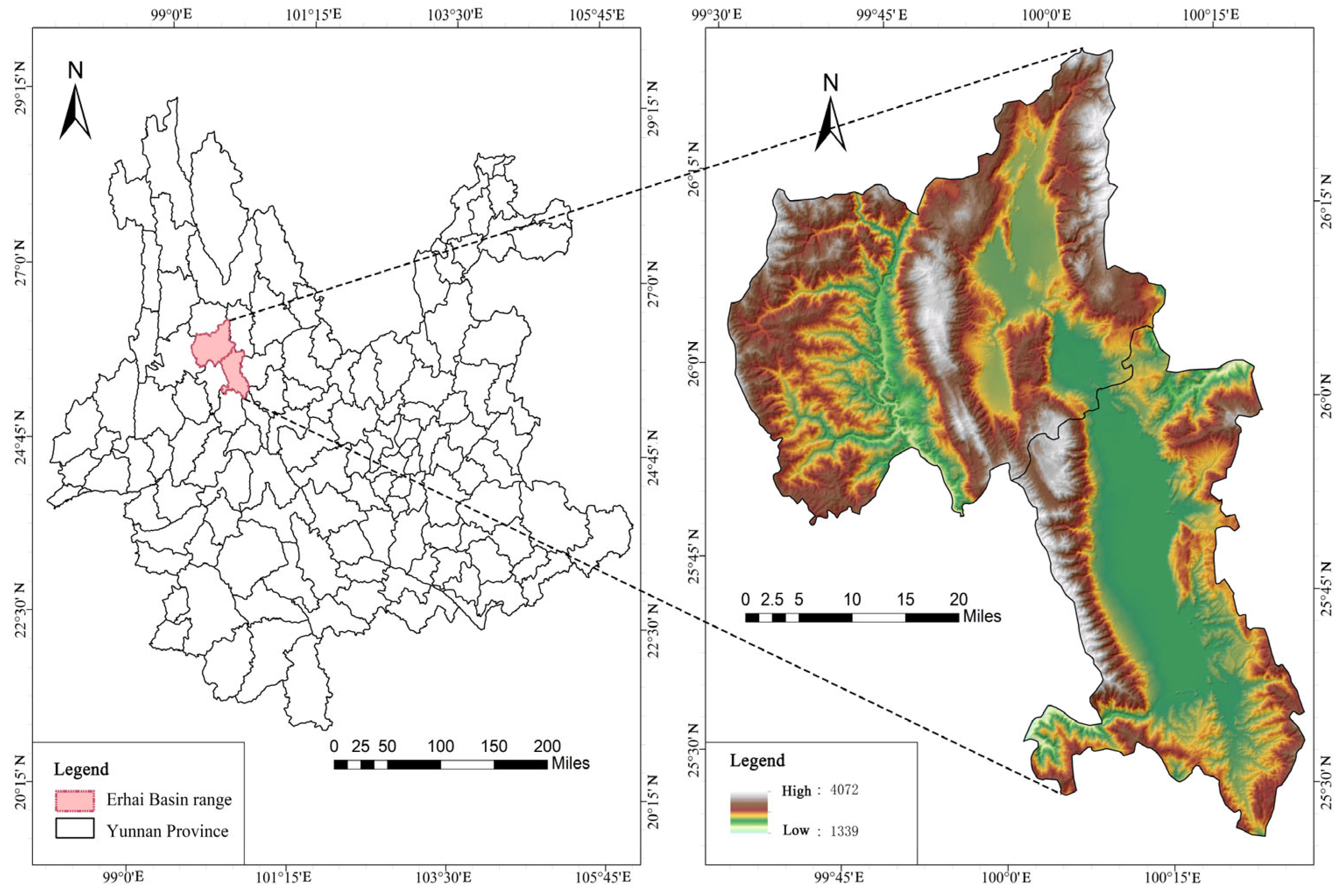
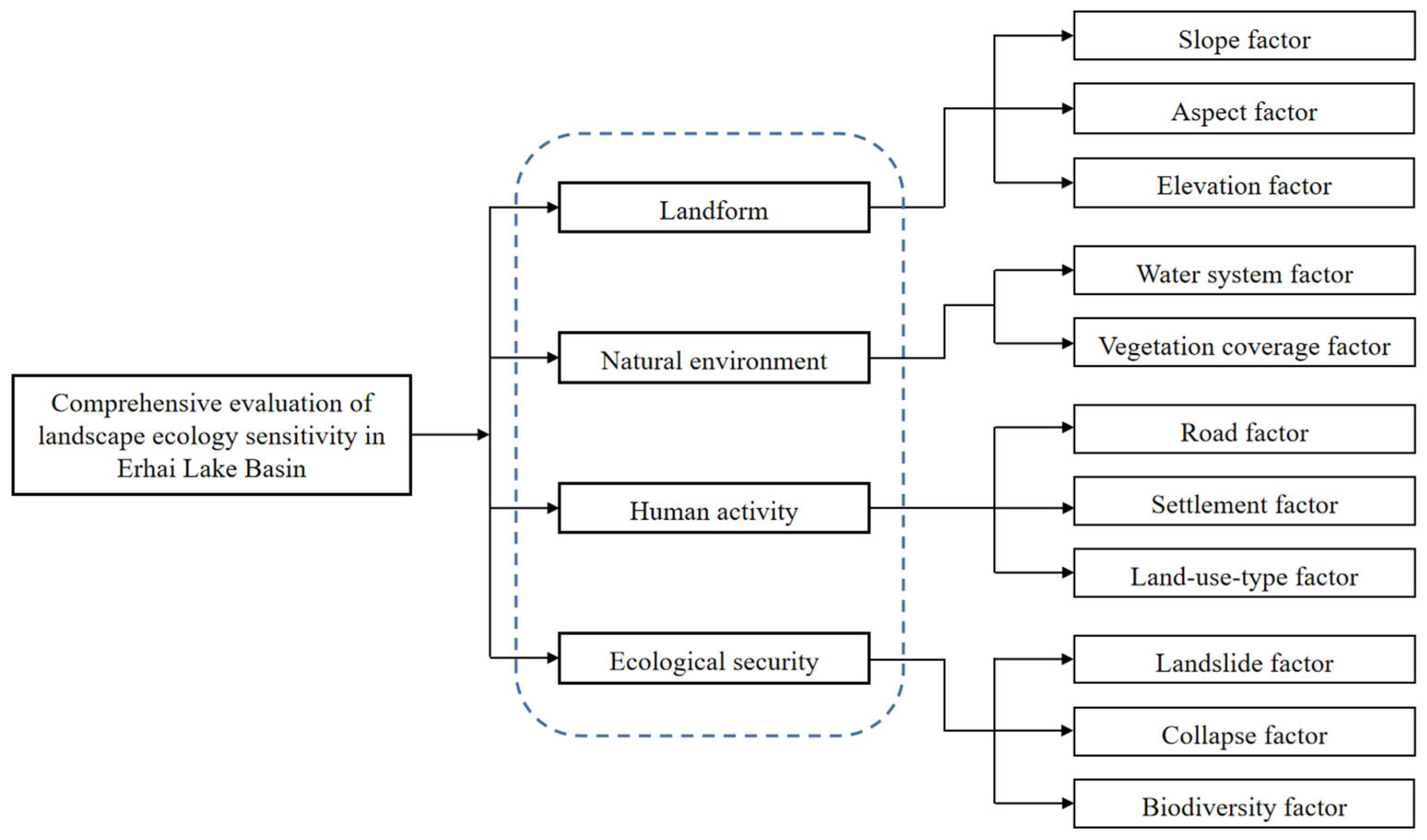

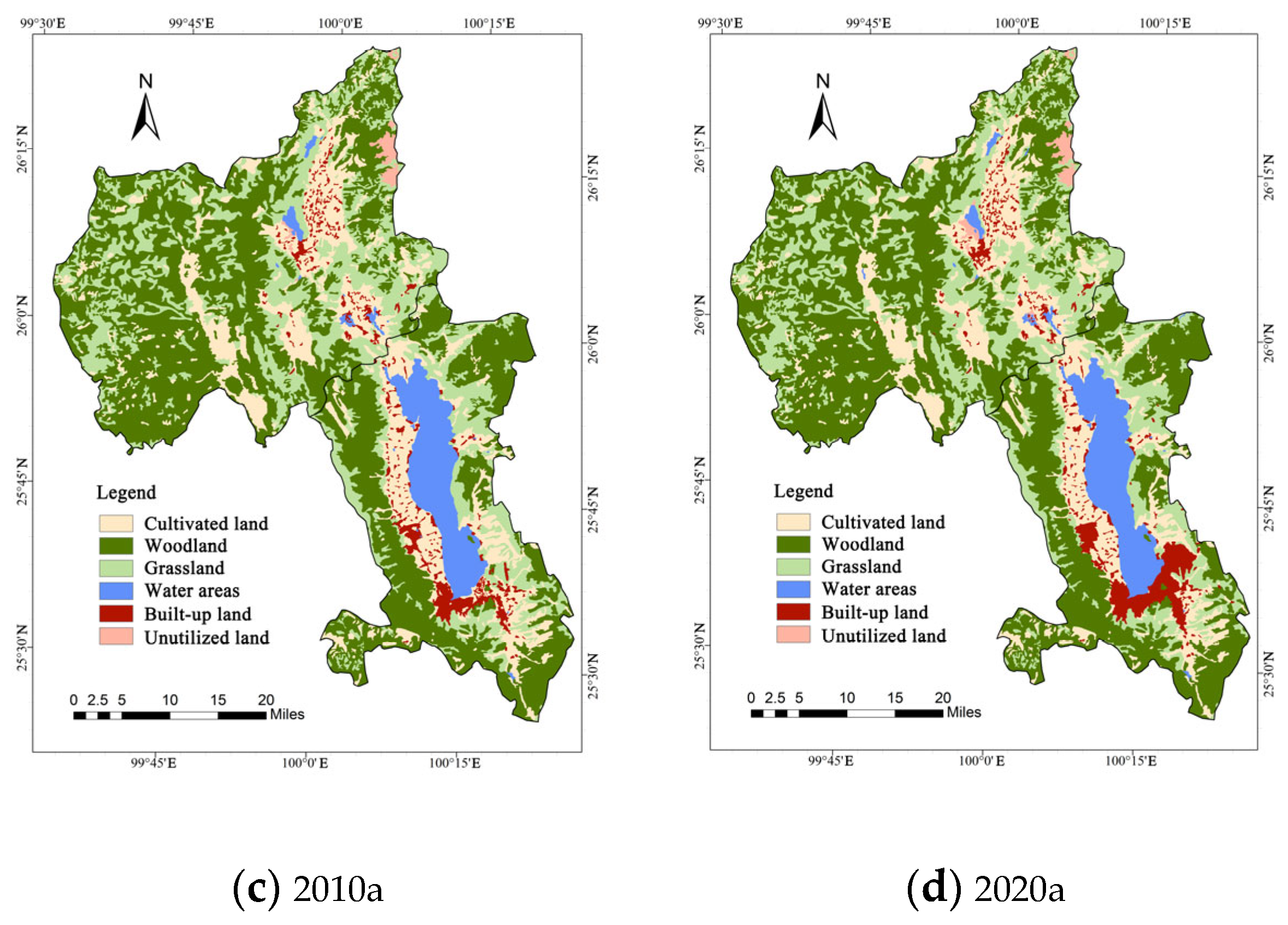
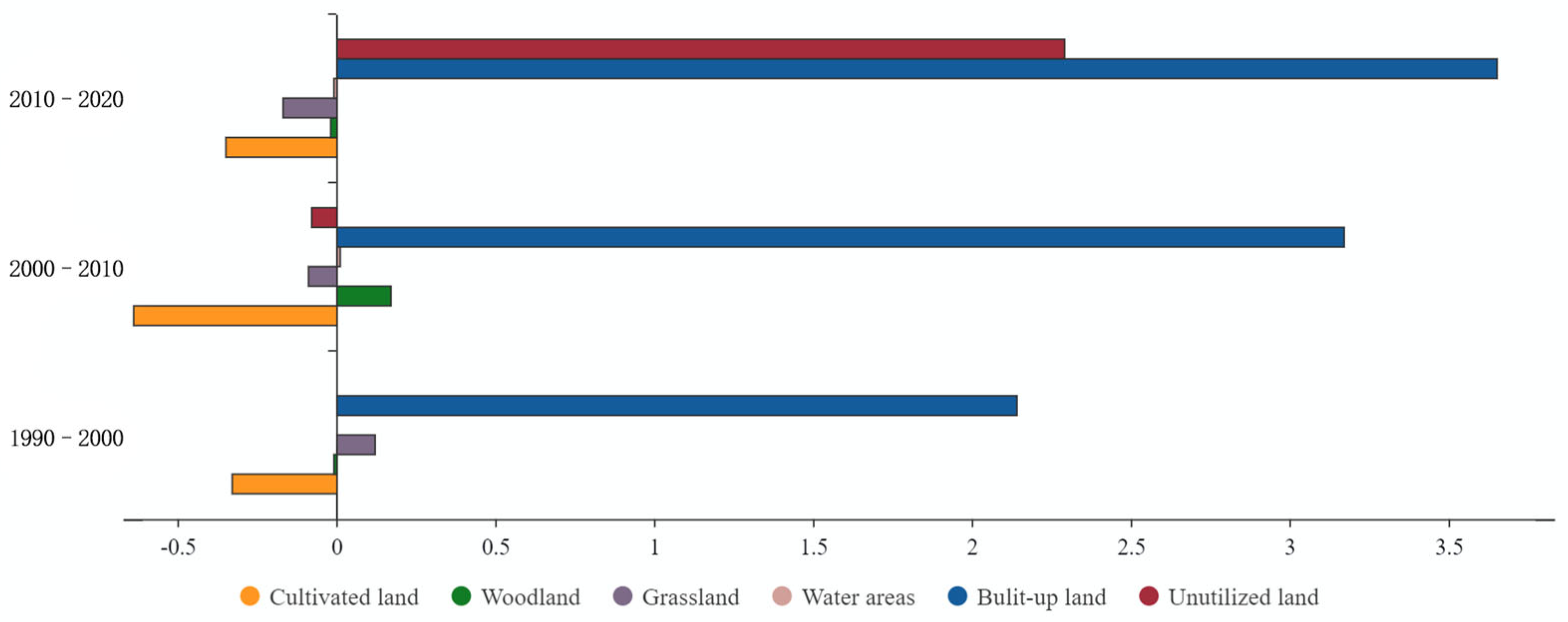
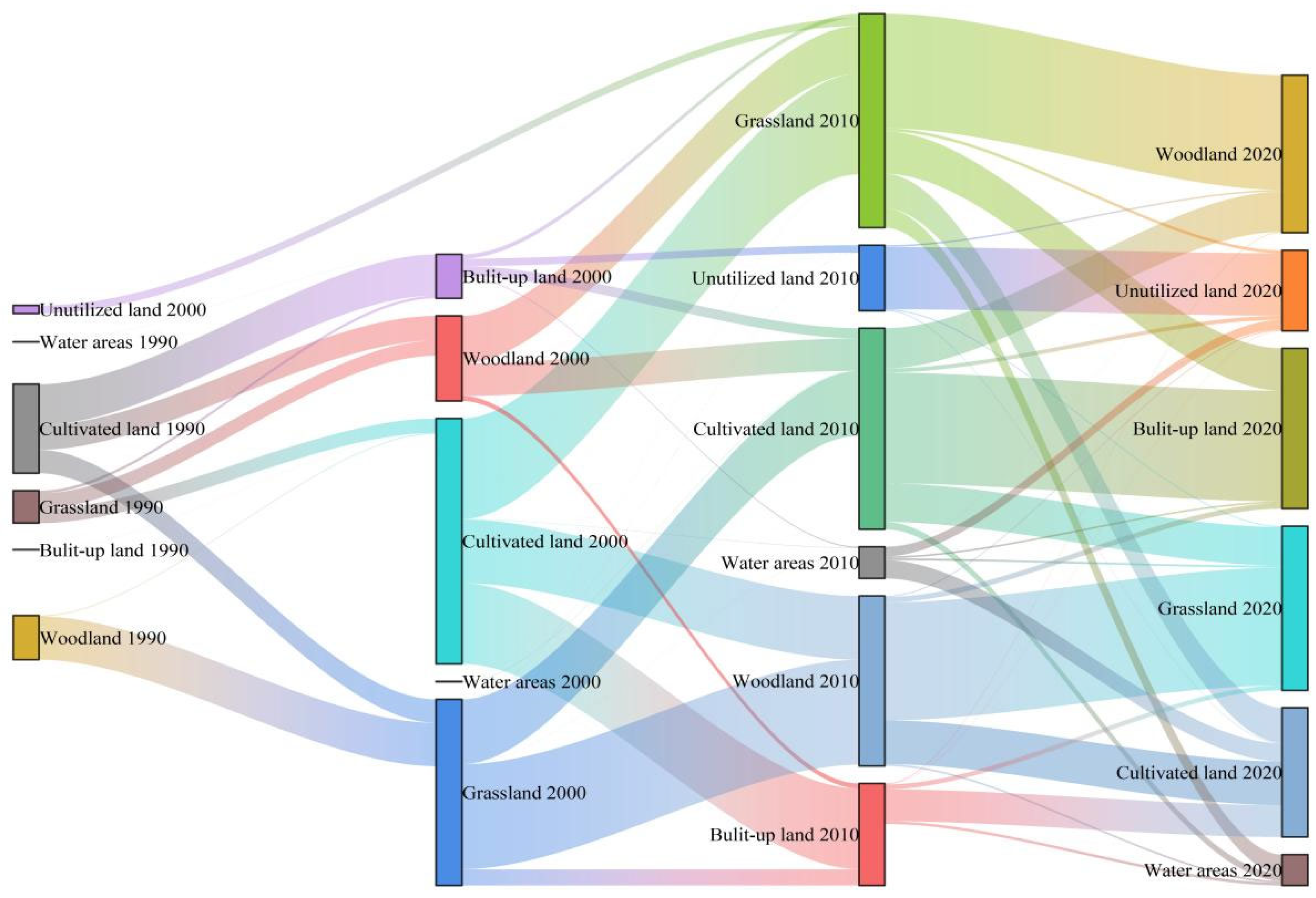
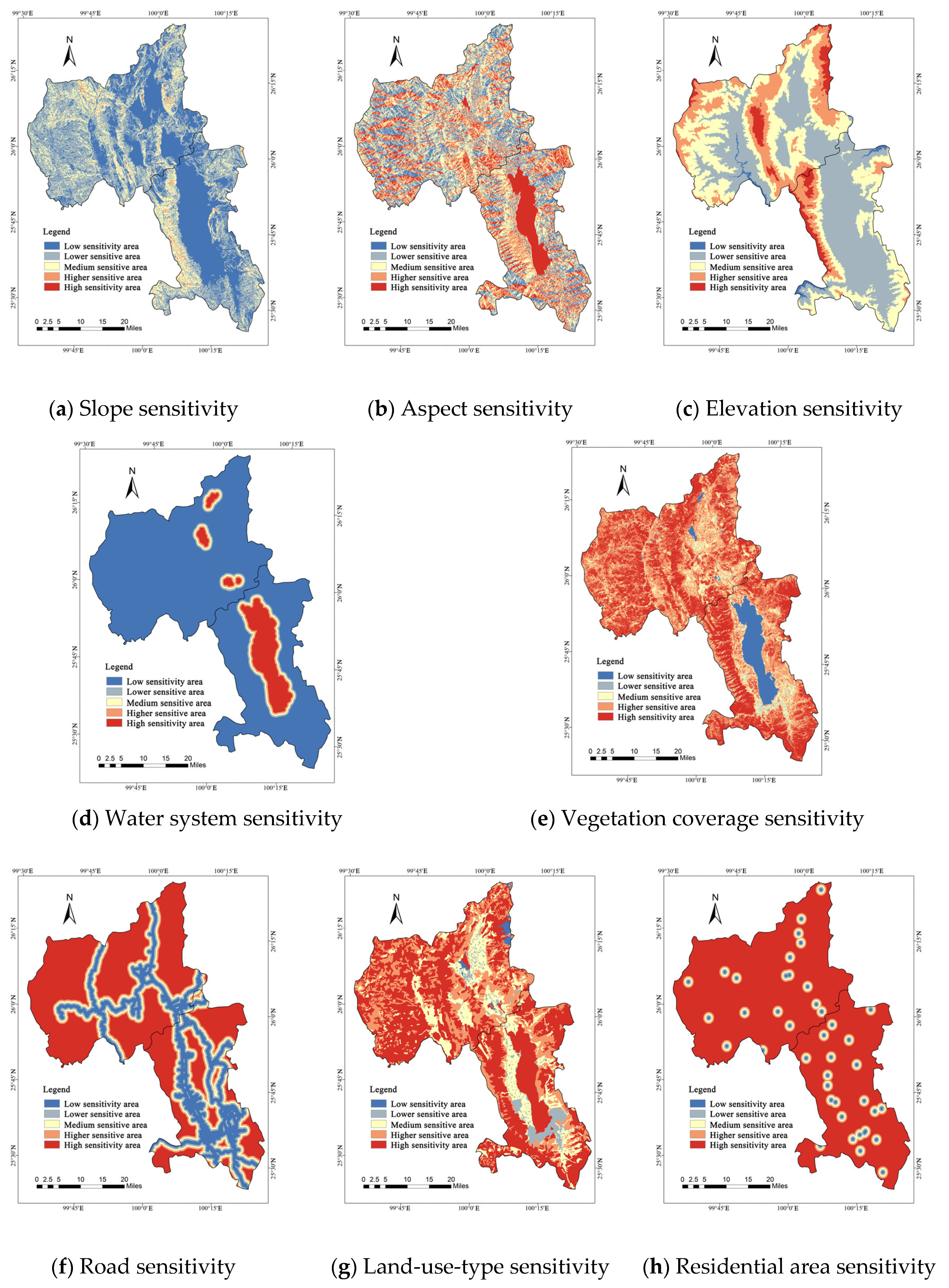


| X | x1 | x2 | x3 | x4 | … | xn |
|---|---|---|---|---|---|---|
| x1 | x1/x1 | x1/x2 | x1/x3 | x1/x4 | … | x1/xn |
| x2 | x2/x1 | x2/x2 | x2/x3 | x2/x4 | … | x2/xn |
| x3 | x3/x1 | x3/x2 | x3/x3 | x3/x4 | … | x3/xn |
| x4 | x4/x1 | x4/x2 | x4/x3 | x4/x4 | … | x4/xn |
| … | … | … | … | … | … | … |
| xn | xn/x1 | xn/x2 | xn/x3 | xn/x4 | … | xn/xn |
| Degree Value | Meaning |
|---|---|
| 1 | Factor i is as important as factor j |
| 3 | Factor i is slightly more important than factor j |
| 5 | Factor i is more important than factor j |
| 7 | Factor i is significantly more important than factor j |
| 9 | Factor i is absolutely more important than factor j |
| 2, 4, 6, and 8 | The intermediate value between the above judgments |
| Reciprocal | Comparing factor i with factor j, the importance ratio is xij and the importance ratio of factor j to factor i is 1/xij |
| Years | Cultivated Land | Woodland | Grassland | Water Areas | Built-Up Land | Unutilized Land | Comprehensive Land-Use Degree |
|---|---|---|---|---|---|---|---|
| 1990–2000 | −0.33% | −0.01% | 0.12% | 0.00% | 2.14% | 0.00% | 0.14% |
| 2000–2010 | −0.64% | 0.17% | −0.09% | 0.01% | 3.17% | −0.08% | 0.30% |
| 2010–2020 | −0.35% | −0.02% | −0.17% | −0.01% | 3.65% | 2.29% | 0.25% |
| Land-Use Type | 2020a (km2) | |||||||
|---|---|---|---|---|---|---|---|---|
| Cultivated Land | Woodland | Grassland | Water Areas | Built-Up Land | Unutilized Land | Total | ||
| 1990a (km2) | Cultivated land | 696.65 | 37.86 | 47.96 | 2.92 | 83.16 | 1.60 | 870.16 |
| Woodland | 18.58 | 1826.15 | 53.90 | 0.67 | 3.83 | 0.43 | 1903.57 | |
| Grassland | 27.27 | 64.67 | 992.14 | 7.40 | 22.31 | 1.19 | 1114.98 | |
| Water areas | 7.04 | 0.07 | 0.75 | 249.67 | 0.53 | 3.70 | 261.76 | |
| Built-up land | 10.16 | 0.01 | 1.38 | 1.14 | 64.24 | 2.82 | 79.75 | |
| Unutilized land | 0.00 | 0.80 | 3.25 | 0.00 | 0.00 | 21.65 | 25.70 | |
| Total | 759.99 | 1929.80 | 1098.94 | 261.78 | 174.07 | 31.33 | 4255.91 | |
| Grading/ Impact Factor (IF) | Landform | Natural Condition | Human Activity | Ecological Security | Grading Assignment | |||||||
|---|---|---|---|---|---|---|---|---|---|---|---|---|
| Slope | Aspect | Elevation/m | Distance from Water Areas/m | Vegetation Coverage | Distance from Road/m | Distance from Residential Areas/m | Land-Use Type | Landslide/° | Collapse/° | Biological Diversity | ||
| Low-sensitivity area | 0°~10° | Due south | h < 1800 | >2000 | 0~0.2 | <500 | <500 | Unutilized land | 0~12 | 0~10 | Woodland; water | 1 |
| Lower sensitivity area | 10°~20° | Southeast; southwest | 1800~2300 | 1500~2000 | 0.2~0.4 | 500~1000 | 500~1000 | Built-up land | 12~24 | 10~20 | Grassland | 3 |
| Medium-sensitivity area | 20°~30° | Due east; due west | 2300~2800 | 1000~1500 | 0.4~0.6 | 1000~1500 | 1000~1500 | Cultivated land | 24~36 | 20~30 | Cultivated land | 5 |
| Higher sensitivity area | 30°~40° | Northeast; northwest | 2800~3300 | 500~1000 | 0.6~0.8 | 1500~2000 | 1500~2000 | Grassland | 36~48 | 30~40 | Built-up land | 7 |
| High-sensitivity area | >40° | Due north | h > 3300 | <500 | 0.8~1 | >2000 | >2000 | Woodland; water areas | >48 | >40 | Unutilized land | 9 |
| Weight | 0.0941 | 0.0373 | 0.0593 | 0.1394 | 0.2788 | 0.12 | 0.0458 | 0.1049 | 0.0223 | 0.0188 | 0.0794 | |
| Sensitivity Factors | Low-Sensitivity Area | Lower Sensitivity Area | Medium-Sensitivity Area | Higher Sensitivity Area | High-Sensitivity Area | |||||
|---|---|---|---|---|---|---|---|---|---|---|
| Area (km2) | Proportion (%) | Area (km2) | Proportion (%) | Area (km2) | Proportion (%) | Area (km2) | Proportion (%) | Area (km2) | Proportion (%) | |
| Slope | 1395.35 | 33.11 | 1522.79 | 36.14 | 1015.27 | 24.09 | 257.63 | 6.11 | 22.75 | 0.54 |
| Aspect | 445.89 | 10.58 | 1000.50 | 23.74 | 1064.15 | 25.25 | 997.96 | 23.68 | 705.34 | 16.74 |
| Elevation | 42.81 | 1.01 | 1819.91 | 42.77 | 1421.89 | 33.41 | 761.48 | 17.89 | 209.47 | 4.92 |
| Water system | 3634.98 | 85.41 | 97.07 | 2.28 | 92.71 | 2.18 | 87.87 | 2.06 | 343.12 | 8.06 |
| Vegetation coverage | 259.47 | 6.10 | 56.21 | 1.32 | 643.89 | 15.14 | 1463.08 | 34.41 | 1829.39 | 43.02 |
| Road | 729.33 | 17.14 | 440.91 | 10.36 | 368.26 | 8.65 | 316.71 | 7.44 | 2400.27 | 56.40 |
| Residential areas | 36.12 | 0.85 | 103.17 | 2.42 | 169.28 | 3.98 | 219.41 | 5.16 | 3727.78 | 87.59 |
| Land-use type | 31.42 | 0.74 | 174.76 | 4.11 | 759.03 | 17.84 | 1098.77 | 25.82 | 2191.77 | 51.50 |
| Landslide | 1655.18 | 39.28 | 1794.16 | 42.58 | 693.02 | 16.45 | 70.23 | 1.67 | 1.05 | 0.02 |
| Collapse | 1395.35 | 33.11 | 1522.79 | 36.14 | 1015.27 | 24.09 | 257.63 | 6.11 | 22.75 | 0.54 |
| Biological diversity | 31.42 | 0.74 | 174.76 | 4.11 | 759.03 | 17.84 | 1098.77 | 25.82 | 2191.77 | 51.50 |
| Sensitivity Factors | Low-Sensitivity Area | Lower Sensitivity Area | Medium-Sensitivity Area | Higher Sensitivity Area | High-Sensitivity Area | |||||
|---|---|---|---|---|---|---|---|---|---|---|
| Area (km2) | Proportion (%) | Area (km2) | Proportion (%) | Area (km2) | Proportion (%) | Area (km2) | Proportion (%) | Area (km2) | Proportion (%) | |
| Comprehensive Sensitivity | 344.73 | 8.18 | 649.19 | 15.41 | 940.42 | 22.32 | 1177.10 | 27.93 | 1102.36 | 26.16 |
Disclaimer/Publisher’s Note: The statements, opinions and data contained in all publications are solely those of the individual author(s) and contributor(s) and not of MDPI and/or the editor(s). MDPI and/or the editor(s) disclaim responsibility for any injury to people or property resulting from any ideas, methods, instructions or products referred to in the content. |
© 2023 by the authors. Licensee MDPI, Basel, Switzerland. This article is an open access article distributed under the terms and conditions of the Creative Commons Attribution (CC BY) license (https://creativecommons.org/licenses/by/4.0/).
Share and Cite
Wang, J.; Song, Y.; Ge, B.; Zhou, Y. Dynamic Spatiotemporal Land Use Evolution in China’s Plateau Lake Basins in Response to Landscape Ecological Sensitivity. Sustainability 2023, 15, 15020. https://doi.org/10.3390/su152015020
Wang J, Song Y, Ge B, Zhou Y. Dynamic Spatiotemporal Land Use Evolution in China’s Plateau Lake Basins in Response to Landscape Ecological Sensitivity. Sustainability. 2023; 15(20):15020. https://doi.org/10.3390/su152015020
Chicago/Turabian StyleWang, Jing, Yuhong Song, Beichen Ge, and Ying Zhou. 2023. "Dynamic Spatiotemporal Land Use Evolution in China’s Plateau Lake Basins in Response to Landscape Ecological Sensitivity" Sustainability 15, no. 20: 15020. https://doi.org/10.3390/su152015020
APA StyleWang, J., Song, Y., Ge, B., & Zhou, Y. (2023). Dynamic Spatiotemporal Land Use Evolution in China’s Plateau Lake Basins in Response to Landscape Ecological Sensitivity. Sustainability, 15(20), 15020. https://doi.org/10.3390/su152015020





